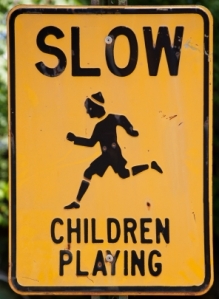 Here’s my little secret: When my kids were young (maybe ages 2-7) I spent far too much time worrying about how tireless/active/hyper they were. In my own non-scientific playground research, I came to the unfortunate conclusion that my kids were on the extreme end of the spectrum for physical activity. This finding exhausted my already-tired self. And honestly it felt unfair. I had three kids — at least one of them should have come out as one of those calm children who spend hours drawing! I was also tired because no matter how many hours those sleep books said my kids should be sleeping, they seemed to need a good 1-2 hours less than recommended, and each rose at 6 a.m. like clockwork.
Here’s my little secret: When my kids were young (maybe ages 2-7) I spent far too much time worrying about how tireless/active/hyper they were. In my own non-scientific playground research, I came to the unfortunate conclusion that my kids were on the extreme end of the spectrum for physical activity. This finding exhausted my already-tired self. And honestly it felt unfair. I had three kids — at least one of them should have come out as one of those calm children who spend hours drawing! I was also tired because no matter how many hours those sleep books said my kids should be sleeping, they seemed to need a good 1-2 hours less than recommended, and each rose at 6 a.m. like clockwork.
On one particularly moody day, I shared these insights with my Mom, assuming she’d feel some sympathy for me. She’d had two girls, and I was sure we were vastly easier to manage than my brood. “That’s exactly what I used to think about you,” she responded emphatically. “It was true too! You were more active than the other girls you played with and don’t even get me started on how little you slept!” My first thought was, I think I’ll keep this from my husband. All these years I’ve been secretly blaming him for our over-active non-sleepers.
Still, my Mom helped me settle down and accept my plight. In the large scheme of things my burden was obviously quite light. I simply had to embrace exercise! My kids were telling me with their bodies that exercise needed to be a large part of our days. I started giving myself regular pep-talks, “These kids are going to keep you in shape! And you can get a lot done when you rise at dawn. Target is practically empty at 8 a.m.” This was the phase of my life when I never wore shoes I couldn’t run in. Come to think of it, I still don’t. Maybe some day I’ll wear flip-flops again.
The more I planned our days around getting enough exercise, the more I came across articles reminding me of its benefits. This knowledge helped on those sleepy mornings when we were the sole people at our neighborhood park at 7:30 a.m. We live in a small, cottage-like house which simply didn’t have the space for the rambunctious activity my kids craved.
Sometimes I look back on that phase of my life, now thankfully a blurry memory, and wonder did I really do that? Then last month I was at a neighborhood party talking with a woman who lives across the street from our local playground. She said, “I remember you! You don’t know me, but I used to watch you playing with your kids at the park on early mornings. I watched you through my kitchen window while I made my breakfast.” So, it must have been me, or Todd, although he complained about it a lot less. (He’s always been an early riser. My kids get that gene from him!)
Okay, the benefits of regular physical activity. It can:
- Boost Cognitive Ability
- Increase Motivation
- Improve Concentration
- Increase Creativity
- Lift Depression (and may be as effective as antidepressants for treating depression)
- Reduce Anxiety
It was motivating to be reminded of these benefits. Most things we do frequently we eventually improve at. Over time Todd and I got better at meeting our kids’ voracious needs for physical activity, mostly by appropriating the resourceful techniques of other desperate parents.
6 Inexpensive Ways to Keep Your Kids Moving Daily
1. The simple frisbee for modified golf. Make sure each child has one of their own. Go to an open space with sporadic trees, fences, or playground equipment and challenge your kids to “hit that faraway tree with the frisbee.” They can count how many tries it takes if this doesn’t start competitive arguments. (In my family it often does.) When they hit the tree, have them try for the next object. Encourage running from throw to throw. I’m slightly embarrassed to admit that we stole this idea from a man exercising his dogs.
2. Time your kids while they move fast. Use the secondhand on your watch, or even better, a basic stopwatch to time your kids doing almost anything aerobic. You’ll be surprised at how many activities kids come up with for you to watch and time. We’ve found it more motivating to measure them against themselves than comparing their time to an older sibling’s.
3. Find other ways to measure your kids’ athletic prowess. I once had 6 kids running back and forth for 45 minutes straight by setting up a long jump course at the playground and measuring their jumps.
4. Fly a kite. As an adult who is not an avid kite flier, I had no memory of how much running went into kite flying. Not only does the person trying to launch the kite run back and forth, but the three kids “chasing the kite” also run like crazy. You just need to make sure the goal isn’t to get the kite flying high (that’s when all the standing around takes place), but for the kids to run around pulling it behind them.
5. Create an indoor obstacle course on rainy days. Crawl under a chair, jump up the stairs, hop in and out of a hula hoop. To keep them going longer, pull out the stopwatch again.
6. Bike with your kids to do errands. Once kids are old enough to bicycle safely on their own, it’s amazing how much calmer they are in the grocery store when they’ve used up their extra energy biking there. Walking at a good pace is also an option for errand-running, and more conducive to conversation.
Of course all this activity wasn’t about training my young kids for future Olympic bids. It was merely satisfying the strong drive their little bodies had to move.
Use Exercise to Support Emotion Regulation in Kids
Early Morning Exercise. When one of my kids has a stressful event taking place at school, I take an early morning walk with him or her that day. Sometimes we talk about the upcoming event or situation, and sometimes we talk about everything but the stressor. But brisk walking before school calms my kids on anxious days.
Exercise as an Antidote to a “Day After Christmas Mood”. This idea was spawned this month out of desperation. Daniel, our 11 year-old, recently played a main role in a musical. He loved everything about it: the practices, his fellow actors, the camaraderie, the performances. And then it was over. I see now that after such a wonderful experience, Daniel had nowhere to go but down. He’d been in a cranky, irritable, fight-provoking mood for two days by the time we finally talked through things. One of the strategies we came up with to help Daniel through this emotional rollercoaster period after his next play, was to have him exercise even more than usual during the post-excitement transition.
3 Ways Well-Timed Physical Activity Can Make a Parent’s Life Easier
1. If kids can run around hard after school, they can put the school day behind them, and sit down to their homework in a calmer state of mind (and body). In addition to this, brain science shows that exercise increases brain volume (both gray and white matter), vascularization, blood flow, and additional functional measures. I’m not even sure what all of these things are, but they sound like they’ll help my kids get their homework done more efficiently and accurately. To me this says less homework help (by parents) and less homework complaining (by children). This works for me!
2. My friend Tina’s daughter has always been a light, finicky eater who hates to stay at the dinner table for long. One year it happened that her daughter’s soccer practice (during which the kids ran all out for much of the time) ended about an hour before dinnertime. During that soccer season, Tina noticed her daughter began eating much more at dinner and was less fidgety at the table. From then on, Tina made it a priority to get her daughter some type of exercise during the pre-dinner time period.
3. I’ve heard similar stories of families with poor sleepers who upped the level of physical activity in their children’s lives and found that the children fell asleep more easily and stayed asleep better. One caveat to this strategy is that the exercise must end at least two hours before bedtime so that the children have enough time to fully wind down from it.

We used to laugh at this sign when we were kids. "Where are all the Slow Children?!"
Now that my kids are older, their bodies seem more and more under their own control. Again, sometimes I wonder if they really were as active as my memory suggests. However, the other day my children found videos we’d made of them as preschoolers. In one I was attempting to interview my 5 year-old son about all his favorites (friend, color, toy, playground activity, etc.). The camera is focused on his chubby-cheeked face as he stands in front of me. But in the corner of the frame you can see the top of another head popping in and out of view. It’s my 3 year-old son Daniel jumping up and down (for no real reason at all) the entire time I’m speaking with his brother.
I guess not quite enough time has passed yet because the image of that day, as cute as it was, gave me a mini post-traumatic reaction to those times of exhaustion. Maybe I need to go get a little exercise now so I’ll feel better!
Other creative ways to keep kids moving? Leave a comment!






